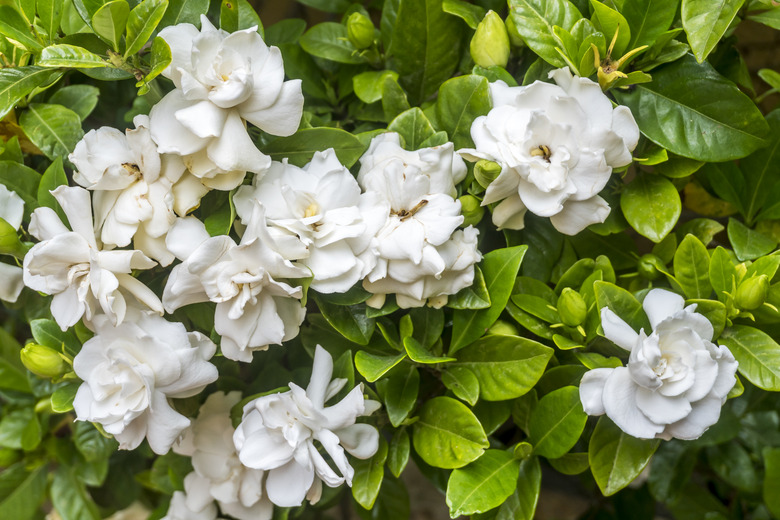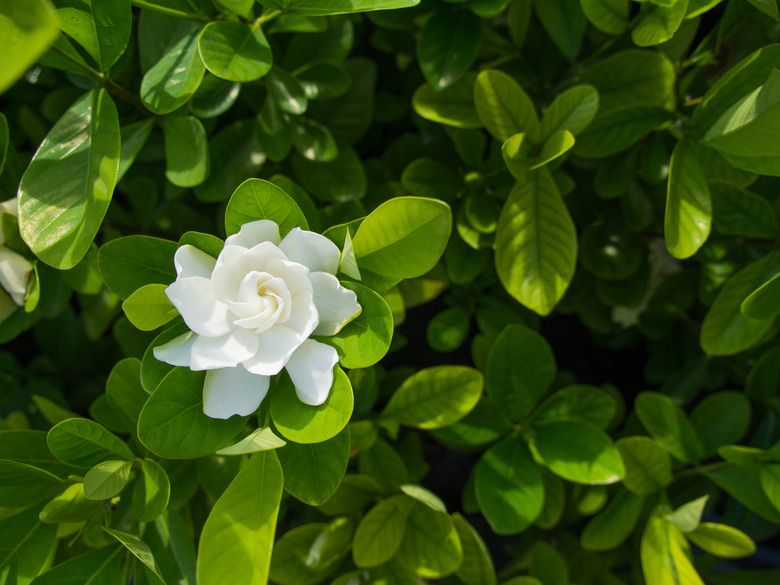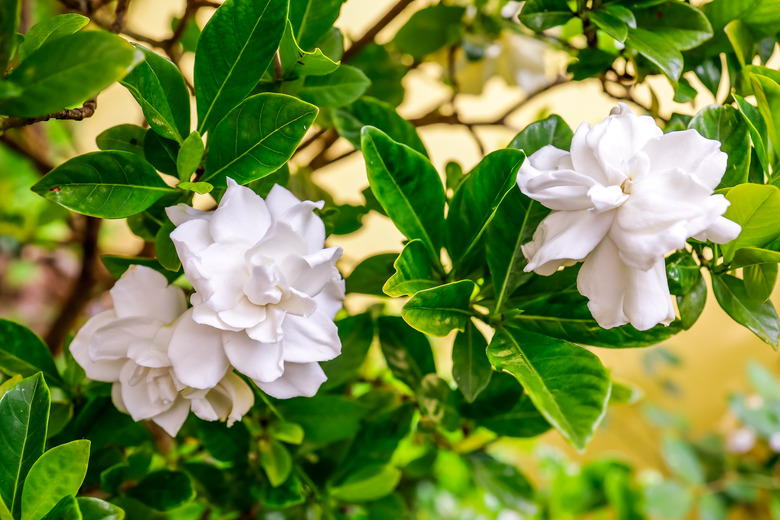How To Grow Gardenias
We may receive a commission on purchases made from links.
- Best uses for gardenias
- How to grow gardenias
- In what zone do gardenias grow best?
- When should you plant gardenias?
- Soil, sunlight and water recommendations for gardenias
- How to propagate gardenias
- How to winterize gardenias
- Common pests and other problems for gardenias
- Common diseases for gardenias
Gardenias (Gardenia jasminoides) are known for their intoxicating fragrance and striking white flowers set against shiny dark-green leaves. While they are a favorite of gardeners in warm climates, the benefits of the plants do require a special commitment. Gardenias, also known as cape jasmine, can be finicky and difficult to grow.
Native to the tropical areas of Asia and Africa, gardenias are evergreen shrubs that like warm, humid growing conditions — but with a twist. They prefer full sun in the morning but a little afternoon shade, especially in very warm areas. Too much sun, especially during hot weather, can scorch the leaves and damage the buds.
Depending on the cultivar, gardenias bloom from spring into early fall. So, it is possible to plant a number of cultivars to enjoy the flowers all season. Cultivars range from large, hedge-type shrubs that can reach heights of 8 feet, such as the double-lowering Gardenia jasminoides 'Fortuniana,' to dwarf varieties that average in the 3-foot to 4-foot range, such as Gardenia jasminoides 'Kleim's Hardy,' to ground cover sizes that only reach about 18 to 24 inches in height, such as Gardenia jasminoides 'Radicans'.
Some cultivars produce a few large 3-inch to 5-inch blooms, while others support multiple smaller flowers. Gardenias attract birds and butterflies, perfect for the gardener who doesn't mind a few guests in the yard.
Best Uses for Gardenias
Best Uses for Gardenias
Plant gardenias to take advantage of their showy flowers and their scent. Place them around doorways and along foundations. Smaller cultivars can be planted in pots and placed on decks and patios. Larger types can be used as privacy hedges. Ground cover cultivars can line a walkway or fill in between other plants.
Gardenias are favorites for cutting gardens, but try to handle the blossoms as little as possible because they can bruise. Cut the stems at a 45-degree angle and remove any leaves that will be below the surface of the water. Another option is to allow the blossoms to float in a bowl of water.
Growing gardenias indoors is difficult. They need six to eight hours of indirect sunlight and high humidity to thrive. Keep them away from air-conditioning and heating vents because they don't like drafts nor changes in temperature.
Create a high humidity environment by placing the pot on a tray that contains gravel and water. The evaporating water will raise the humidity level around the plant. You can also place a humidifier near the plants. Frequent misting of the plants also raises the humidity level in the area.
How to Grow Gardenias
How to Grow Gardenias
- Common Name: Gardenia
- Botanical Name: Gardenia jasminoides
- When to Plant: Fall or spring
- USDA Zones: 7-11
- Sun Exposure: Morning sun with afternoon shade
- Soil Type: Moist, well-draining soil that is slightly acidic
- When It's in Trouble: Leaves turn brown or have brown spots, usually caused by poor-draining soil or low humidity, although brown leaves can signal a pest infestation
- When It's Thriving: Leaves are dark green and shiny
Starting Gardenias From a Seedling
Most gardenias are started from cuttings, or they are purchased as young plants that are transferred to the garden. However, you can also start them from seeds. Gardenias are temperamental, so it is important to handle them with care when transplanting to the garden. They are one of those plants that like to be planted a little higher than the surrounding soil. Dig a hole that is as deep as the root ball and about twice as wide. Pack about 3 or 4 inches of soil at the bottom of the hole and place the plant on top of it.
Have a helper hold the plant steady while you refill the hole with the same soil you removed. Pack the soil lightly as you fill. Water deeply and apply about 4 inches of compost mulch to the area. Be sure to keep the mulch from touching the stem of the plant.
In What Zone Do Gardenias Grow Best?
In What Zone Do Gardenias Grow Best?
Gardenias can grow in plant hardiness zones 7 to 11, but most types are best suited to zones 8 through 11. There are only a few cultivars that can grow in Zone 7, such as Gardenia jasminoides 'Kleim's Hardy' and Gardenia jasminoides 'Frostproof.' Choose a more cold-hardy cultivar if you are on the cusp of zone 8 and if the microclimate in your yard is a little cooler than the surrounding area.
In general, plants like daytime temperatures of 65 to 70 degrees Fahrenheit and 60 to 65 degrees at night. Place the plants where they can enjoy a good dose of morning sun but provide some relief from the sun in the afternoon. In cold areas, bring potted gardenias indoors. You will need to provide a sunny area near a window as well as the necessary humidity.
When Should You Plant Gardenias?
When Should You Plant Gardenias?
Plant gardenias in the fall or spring when outside temperatures are moderate. In colder areas, plant in the spring after the last frost date so that the plants become established by winter. If planting in the fall, plant about six weeks before the first frost date.
Choosing the right planting site is important when dealing with gardenias. Not only are they finicky about their growing conditions but they do not do well if they need to be moved.
Soil, Sunlight and Water Recommendations for Gardenias
Soil, Sunlight and Water Recommendations for Gardenias
Gardenias do best on fertile, well-draining soil that is somewhat acidic, with a pH of 5.0 to 6.5. The pH indicates the acidity and alkalinity of the soil on a scale of 1 to 14. A rating of 7.0 is considered neutral. The only way to determine the pH is through a soil test.
You can take soil samples to a garden center or to your local county extension office for testing. There are also DIY soil test kits. If you are planning on foundation plantings, test the soil along the foundation as well as the middle of the yard because the concrete used in the foundation is very alkaline. You can increase the acidity of soil by adding sulfur or a packaged soil acidifier.
Loamy, well-draining soil is best for gardenias. Loosen heavy clay soil and firm sandy soil by adding compost. If possible, amend the soil about six months before planting, especially if you need to alter the pH, to give the amendments time to work. Apply a slow-release fertilizer for acid-loving plants in midspring and then again in midsummer.
Gardenias benefit from full sun. However, in very warm climates, the plants need some shade in the afternoon.
The plants will need about 1 inch of water per week. In dry areas, you may need to water deeply once a week, especially during the first year. Water in the morning to cut down on evaporation. If possible, use drip irrigation to keep water off the leaves of the plant because water can cause brown spots on the leaves.
How to Propagate Gardenias
How to Propagate Gardenias
You can extend your gardenia collection by taking cuttings from existing plants. In spring when the plant is actively growing, take a 4-inch or 5-inch tip cutting from a healthy stem that contains a number of leaves. Remove all but two sets of leaves near the top of the cutting.
Dip the cut end into rooting hormone. Press the cutting in a mixture of potting soil, perlite and water. Move the pot to a shady spot. Mist the leaves that remain on the cutting. Keep the soil moist and mist the leaves daily.
The cutting should develop roots in four to eight weeks. Transplant to a larger pot and move the plant where it receives morning sunlight during the period when its roots are growing. When the root system is established in the pot, the plant is ready to be transplanted into the landscape.
How to Winterize Gardenias
How to Winterize Gardenias
Gardenias are heat-loving plants, so choosing a cultivar suited to your climate is one of the best ways to protect the plant during the winter months. To prepare for colder weather, add a few inches of mulch around the base of the plant, extending out about 12 inches. Don't fertilize after midsummer because fertilizer can spur new growth that may be harmed during a cold snap. Reduce watering in the late fall and water only when the top few inches of soil are dry to the touch.
If you do expect a sudden frost, cover the plants with a blanket. There are manufactured plant covers for this purpose. If you use a cover, be sure not to damage any branches. Remove the covers during nice weather.
Bring potted gardenias indoors, if possible, during extremely cold weather. Just remember that indoor winter air can be very dry, so you will have to supply the needed high humidity for the plants. Another option is to cover the plants and keep them outside but in a place where they are sheltered from the wind.
Common Pests and Other Problems for Gardenias
Common Pests and Other Problems for Gardenias
Aphids, scales and spider mites can all attack the leaves of gardenias. Leaves that turn brown are a sign of a pest infestation. Check plants frequently. If you find signs, remove the insects with a jet of water from your garden hose. It's best to avoid using insecticides, even insecticidal soap, which can injure soap-sensitive gardenias.
Other things that cause brown leaves include inadequate light, slow-draining soil and soil with the wrong pH. Gardenias like a pH between 5.0 and 6.5. A pH that is too high interferes with the plant's uptaking iron from the soil, which the plant needs to produce chlorophyll. Test the soil, adjust the pH and apply a foliar feed that contains iron. A period of cool weather can also turn the leaves brown.
In some cases, flower buds will form but then drop off the bush before opening. This is usually caused by overwatering or underwatering, insufficient light or poor-quality soil. Bud drop can also be the result of a pest infestation.
Common Diseases for Gardenias
Common Diseases for Gardenias
Root rot is the result of a number of fungal pathogens that attack the roots of the plant. Leaves that turn yellow are the warning sign. If you can pull the plant out of the ground easily and the roots are mushy, you have root rot. Often, poorly draining soil and overwatering are the culprits that lead to the fungi developing. Discard the plants.
Root rot is not the only cause of yellow leaves. Other possible causes include a pH that is too high, an iron deficiency, inadequate sunlight and overwatering or underwatering.


